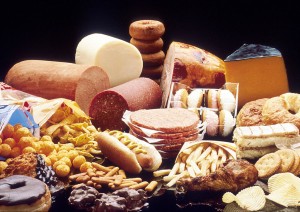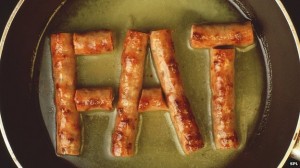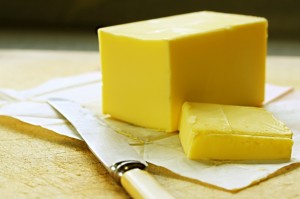By Scott Robinson. There’s some serious confusion about saturated fat, and whether it is bad for the heart and is associated with diseases such as diabetes, stroke, and cancers.
The demonization of saturated fat began about 100 years ago, when a researcher fed a rabbit a high cholesterol carnivore diet and observed that its arteries became blocked with plaque. However, this really took shape in the Fifties with the Seven Countries study by Ancel Keys(1), who reported that a higher saturated fat  intake was associated with a higher cholesterol level and a higher rate of heart disease. The basic premise on which this condemnation lies is that saturated fat (found in foods such as meat, eggs, dairy products, coconut and palm oil) raises cholesterol which in turn, increases the risk of clogged arteries (atherosclerosis). Subsequently, the emergence of low-fat diets and ‘fat-free’ foods has spread with whipping speed and sweep with millions of people deciding to put low fat items into their shopping trolley in the belief that it is doing them good. But is fat, specifically saturated fat, the real criminal here or have we been somewhat misguided by company-funded research, fat-phobic conventional medical wisdom and the advertising prowess of a concept that now encompasses a multi-million dollar industry?
intake was associated with a higher cholesterol level and a higher rate of heart disease. The basic premise on which this condemnation lies is that saturated fat (found in foods such as meat, eggs, dairy products, coconut and palm oil) raises cholesterol which in turn, increases the risk of clogged arteries (atherosclerosis). Subsequently, the emergence of low-fat diets and ‘fat-free’ foods has spread with whipping speed and sweep with millions of people deciding to put low fat items into their shopping trolley in the belief that it is doing them good. But is fat, specifically saturated fat, the real criminal here or have we been somewhat misguided by company-funded research, fat-phobic conventional medical wisdom and the advertising prowess of a concept that now encompasses a multi-million dollar industry?
Saturated Fat is Essential for a Healthy Life
Fatty acids play several key roles in the body; they are essential components of all cell membranes, they are responsible for the absorption of the fat-soluble vitamins A, D, E and K, and include the essential n-3 and n-6 poly-unsaturated fatty-acids (PUFA).
The evidence that saturated fat is bad is limited. In fact, contemporary research states quite the opposite. A recent meta-analysis of prospective cohort studies(2) showed that the intake of saturated fat is not associated  with an increased risk of coronary heart disease, stroke or those two combined (i.e. cardiovascular disease, CVD) before(2) or after(3) adjustment for serum total cholesterol. What’s more, an eloquent study published in the journal Nutrition(4), where researchers looked at the average intake of saturated fat in 41 European countries in 1998 (the latest available data) and the age-adjusted risk of mortality from heart disease, revealed something quite remarkable:
with an increased risk of coronary heart disease, stroke or those two combined (i.e. cardiovascular disease, CVD) before(2) or after(3) adjustment for serum total cholesterol. What’s more, an eloquent study published in the journal Nutrition(4), where researchers looked at the average intake of saturated fat in 41 European countries in 1998 (the latest available data) and the age-adjusted risk of mortality from heart disease, revealed something quite remarkable:
More saturated fat, less heart disease; less saturated fat, more heart disease!
That is, as percentages of saturated fat increased, rates of death from heart disease fell. For example, France who consumed the most saturated fat (15.5% of diet) had the lowest rate of heart disease in all of Europe, whereas Bosnia and Herzegovina who consumed very little saturated fat (<4% of diet) had the highest incidence of heart disease. It is worth baring in mind that ecological data such as this doesn’t necessarily prove that saturated fat can protect against heart disease, but it can more or less disprove a theory as let’s face it, it’s difficult to believe that saturated fat is a major contributor to heart disease when Europeans who are consuming it in abundance are so much healthier, without exception.
So, who is the Culprit?
A comprehensive review of studies on saturated fat, carbohydrates and cardiovascular disease by Kuipers et al. in 2011(5) purported that it is the accumulation of saturated fat in body lipids which should concern us and not the damaging effects of dietary saturated fat per se. Take for instance a study published in Lipids(6) which found that when subjects with the metabolic syndrome were fed either a low-CHO/high fat diet with high saturated fat content or a high-CHO/low-fat diet with low saturated fat content, the low-CHO/high-saturated fat diet resulted in lower saturated fat levels in plasma lipids compared with the high-CHO/low-saturated fat diet. What’s more, an analysis of studies found that replacing saturated fat by CHO with a high glycemic index was associated with a whopping 33% increased risk of myocardial infarction(7). Such findings suggest that replacing saturated fat with carbohydrate in the diet, particularly those with a high glycemic index, may increase risk of heart disease.
N-6 vs. N-3 PUFA
Epidemiological and clinical studies show that PUFA plays a key role in the protection against CVD which has led to the suggestion that replacing saturated fat with PUFA is beneficial to cardiovascular health. A prospective study of cholesterol, apolipoproteins, and the risk of myocardial infarction found that replacing 5 en% saturated fat by 5 en% PUFA reduces the risk of coronary heart disease by 9.1% (8). Interestingly, Kuipers et al. (5) reported that the replacement of SAFA with n-6 PUFA (notably linoleic acid) shows no health benefit and may actually signal towards increased CVD risk which tells us that the protective role of PUFA in the diet lies with n-3 PUFA!
Take-Home Message:
Going ‘low-fat’ isn’t a particularly good option for weight loss nor health and well-being. Fat forms an essential component of the diet and there is increasing evidence to suggest that increasing saturated fat to ~15% total daily intake isn’t hazardous to heart health and may indeed provide a protective effect against heart disease. It is worth noting that many fat-free or low-fat foods are crammed with artificial sugars and sweeteners and therefore many of us who do go ‘low-fat’ often replace fat with carbohydrates; the consequences of which appear to be an increased risk of heart disease as well as other uncommunicable diseases such as diabetes and cancers. It goes without saying that we must not over-indulge ourselves with saturated fat, but eating less dietary carbohydrate (particularly those with a high-glycemic index), trans-fatty acids and linoleic acid, while increasing the consumption of fish, red meat, vegetables and fruit may be an attractive means of keeping our heart healthy.
‘Our genes should be well adapted to eating ~15% saturated fat – 2 x that recommended as maximum by USDA, yet as much as the healthiest populations in Europe’ Coincidence?
References:
Keys A. B. (1980). Seven countries: a multivariate analysis of death and coronary heart disease. London, England: Harvard University Press, Cambridge Massachusetts.
Siri-Tarino, P. W., Sun, Q., Hu F. B., et al. (2010). Meta-analysis of prospective cohort studies evaluating the association of saturated fat with cardiovascular disease. American Journal of Clinical Nutrition, 91, 535-46.
Scarborough, P., Rayner, M., van Dis I., et al. (2010). Meta-analysis of effect of saturated fat intake on cardiovascular disease: over-adjustment obscures true associations. American Journal of Clinical Nutrition, 92, 458-464.
European cardiovascular disease statistics (2008 edition). British Heart Foundation Health Promotion Research Group Department of Public Health, University of Oxford and Health Economics Research Centre, Department of Public Health, University of Oxford.
Kuipers, R. S., de Graaf, D. J., Luxwolda, M. F., Muskiet, M. H. A., Dijck-Brouwer, D. A. J, & Muskiet, F. A. J. (2011). Saturated fat, carbohydrates and cardiovascular disease. Netherlands, The Journal of Medicine, 69, 372-378.
Volek J. S., Phinney, S. D., Forsythe, C. E, et al. (2009). Carbohydrate restriction has a more favourable impact on the metabolic syndrome than a low fat diet. Lipids, 44, 297-309.
Jakobsen, M. U., Dethlefsen, C., Joensen, A. M., et al. (2010). Intake of carbohydrates compared with intake of saturated fatty acids and risk of myocardial infarction: importance of the glycemic index. American Journal of Clinical Nutrition, 91, 1764-8.
Stampfer, M. J., Sacks, F. M., Salvini, S., et al. (1991). A prospective study of cholesterol, apolipoproteins, and the risk of myocardial infarction. New England Journal of Medicine, 325, 373-81.
Bio: Scott is a Doctoral Researcher in Exercise Metabolism at the University of Birmingham, UK. He holds a First Class Honours degree in Sports Science and a Masters with Distinction in Sports Physiology. He currently works as a Nutrition advisor for Myprotein UK who are the UK’s number one online sports nutrition company. For regular updates on the latest in exercise metabolism and nutrition, follow Scott on Twitter @scottrobinson8 or if you have any questions please feel free to email him slr247@bham.ac.uk





